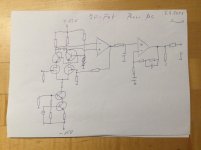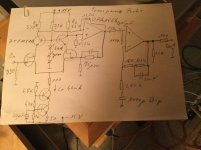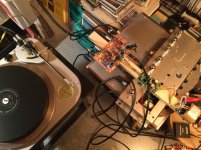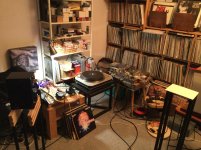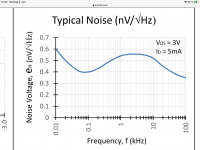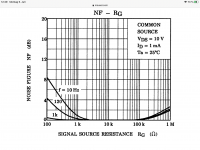Joachim,
Is the choice for IF3602 based on noise ?
If soo, would multiple 2SK369 in parallel not give similar results ?
Thanks,
Patrick
Is the choice for IF3602 based on noise ?
If soo, would multiple 2SK369 in parallel not give similar results ?
Thanks,
Patrick
Of you want to get 750mS you need a massive amount. In theory it is possible though. We called that paralleling for low voltage Noise Faulkner Circuit in the old days.
Using the Spice Model from Interfet, I calculated the Yfs of the IF3602 to be ~ 160mS at 20mA.
The same can be achieved by 4x 2SK369 in parallel, each running at 5mA.
Capacitances are the same or somewhat smaller.
And I think noise is same too, at least at 1kHz.
More FET noise measurements (for EUVL)
Patrick
The same can be achieved by 4x 2SK369 in parallel, each running at 5mA.
Capacitances are the same or somewhat smaller.
And I think noise is same too, at least at 1kHz.
More FET noise measurements (for EUVL)
Patrick
I do not know exactly why but I like the sound of the Interfet. It is very clean and open.
I will try to raise the idle too.
I will try to raise the idle too.
For example when I take away one green LED the Fet runs on ca. 2,95V. When I raise the idle to 100mA each half we burn 0,295 W ( V x I ). That is what the Fet just can stand in dissipation.
Sorry, both sided contribute to the heat so 50mA each is the maximum we can reach under those conditions. Anyway, I will measure the actual circuit to see what voltage is over the Fets right now.
Joachim. I made a RIAA inverter circuit by Peter Walker. It is very useful. Not least because it is simple and has defined error. It causes a little motorboating in a NAD3020. This subsides after 5 minutes. Subtly it's always there. I suspect it sounds very nice and is why a Garrard 401/LP12 sounds nice. Buxtehude knew this? It has another perfect error. THe curve suits Royd Abbot speakers. I bought a pair very cheaply and now almost wish I hadn't ( Covid project ). Martina has a lovely small titanium speaker. Are you guilty of that? I think it takes a year to run in. My Colleen has a pair. 100 Hz 10 kHz EQ suits well.
If we could build a very small passive EQ for each and every source ( not to correct RIAA ) we might have better sound. Even using very awful RCA cables it is the better solution. My friend says I should have thought of this before he threw his EPOS ES14 out of the house. It's the Bose idea done right. The speaker must be OK to start with. Twin T filters are too chalenging for this idea if wanting simplicity. The next stage needs to be factored in. The Walker circuit side steps that. The NAD being very generic means if it works for me it should work for all. Covid laziness made we not change the subsonics. I live with the first five minutes. Best " mistake " I ever made.
This looks the same.
Reverse RIAA
If we could build a very small passive EQ for each and every source ( not to correct RIAA ) we might have better sound. Even using very awful RCA cables it is the better solution. My friend says I should have thought of this before he threw his EPOS ES14 out of the house. It's the Bose idea done right. The speaker must be OK to start with. Twin T filters are too chalenging for this idea if wanting simplicity. The next stage needs to be factored in. The Walker circuit side steps that. The NAD being very generic means if it works for me it should work for all. Covid laziness made we not change the subsonics. I live with the first five minutes. Best " mistake " I ever made.
This looks the same.
Reverse RIAA
Everybody has his own anti RIAA. I stick to Lipshitz, passive and active.
When modern RIAA was born, they where taking parts they had.
Plus - Minus 10% was the order of the day. When it comes to speakers it is still so.
Noise can help . Sure. I call that analog dither. It hides distortion in the noise. A shark works with stochastic noise avaraging. He can sense pray many hundred meters away. And that in a very noisy einvironment. I prefer low noise, high speed electronics though. The artist should decide on the noise level and frequency content and not me.
When modern RIAA was born, they where taking parts they had.
Plus - Minus 10% was the order of the day. When it comes to speakers it is still so.
Noise can help . Sure. I call that analog dither. It hides distortion in the noise. A shark works with stochastic noise avaraging. He can sense pray many hundred meters away. And that in a very noisy einvironment. I prefer low noise, high speed electronics though. The artist should decide on the noise level and frequency content and not me.
I designed that Titanium speaker, yes. It was debree from a project for Audioquest to make something like the Tivoli radio. Martina found it in the thick bay. And so it goes.
